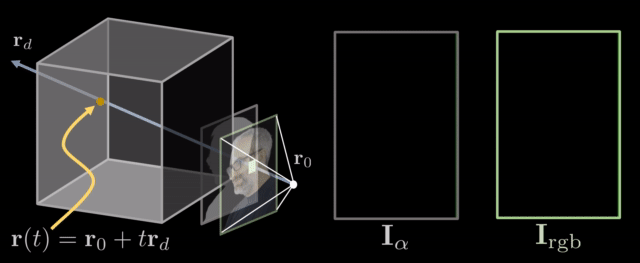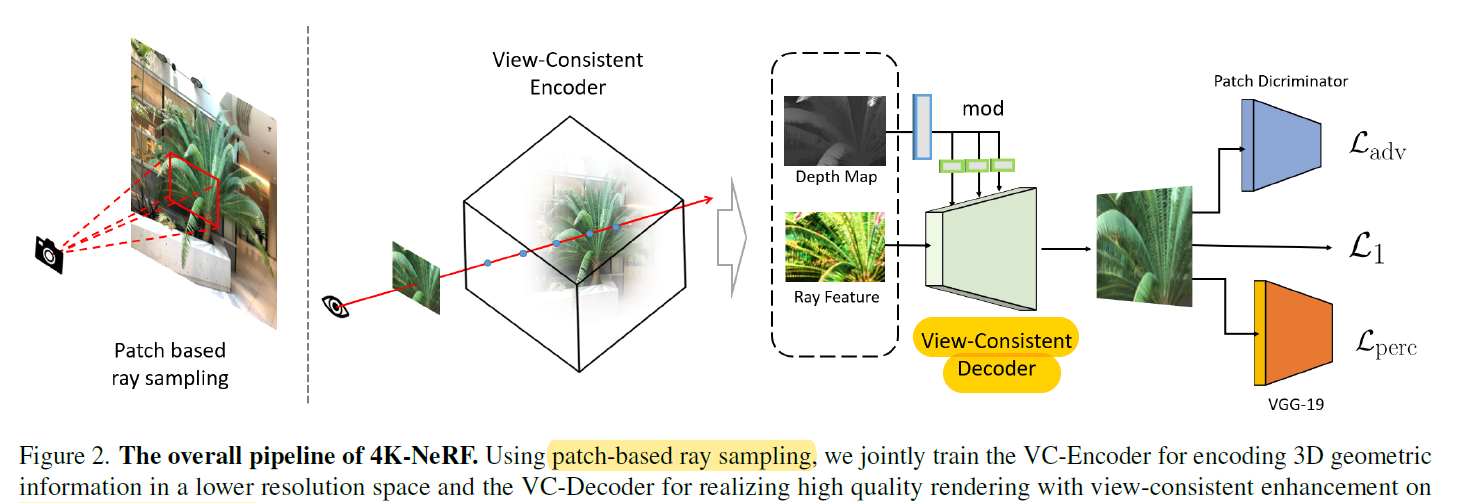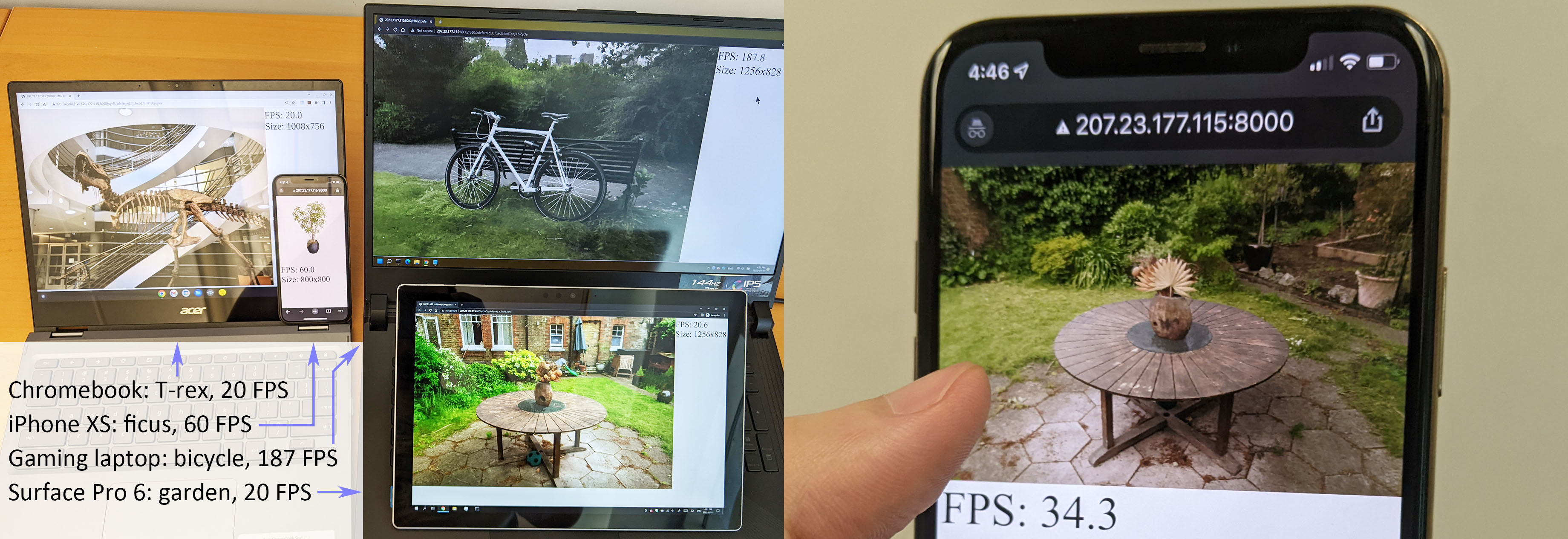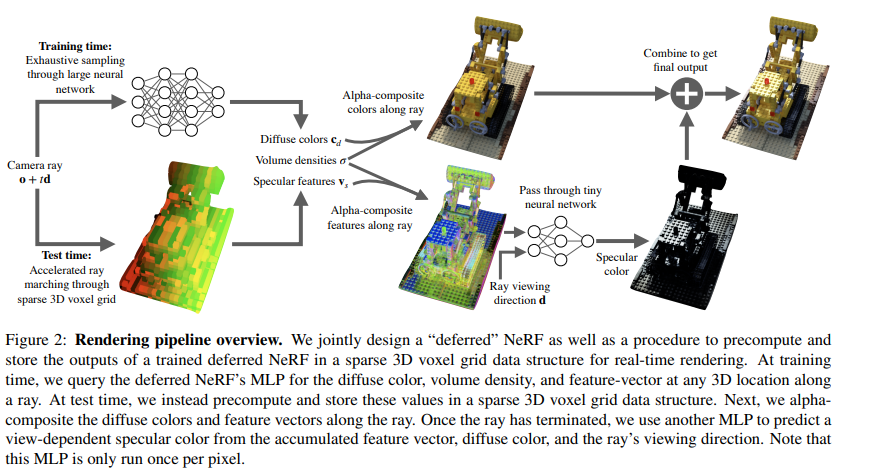-
Notifications
You must be signed in to change notification settings - Fork 3
6) Nerf rendering, compositing and web viewing
- Nerf Rendering Basics
-
Web rendering
- Conversion to mesh or voxel
- Real-Time Neural Light Field on Mobile Devices, 2022
- MERF: Memory-Efficient Radiance Fields for Real-time View Synthesis in Unbounded Scenes, 2023
- Real-Time Neural Appearance Models, 2023
- Compression
Table of contents generated with markdown-toc
Faster Inference and real time rendering will be crucial to see Nerf adopted widely.
At the moment a high end NVIDIA graphics card is required severely limiting the number of machines Nerf's can be generated an viewed on on unless cloud computing is used.
Neural radiance field (NeRF) use techniques from volume rendering to accumulate samples of this scene representation along rays to render the scene from any viewpoint called raymarching.


Raytracing (geometry) vs raymarching (volumes)

Ray tracing means analytically determining intersection between a ray and some geometry. Lets take the example of a sphere and a ray. Using math you can calculate exactly if the ray will hit that sphere and exactly where. The great part is that math doesn’t involve any iteration. So what that means is that regardless of where your ray is, where or how far away the sphere is, you will ALWAYS be able to calculate the intersection position (or lack thereof) with a few math operations.
ray marching works on all sorts of fun SDFs but is iterative and slower. Ray marching is a little different, particularly with signed distance fields (SDF). The marching is an iterative process based on the SDF. What that means is that it’s interactive and that performance WILL change based on your SDF and the position of your sphere.


In NeRF we take advantage of a hierarchical sampling scheme that first uses a uniform sampler and is followed by a PDF sampler.
The uniform sampler distributes samples evenly between a predefined distance range from the camera. These are then used to compute an initial render of the scene. The renderer optionally produces weights for each sample that correlate with how important each sample was to the final renderer.
The PDF sampler uses these weights to generate a new set of samples that are biased to regions of higher weight. In practice, these regions are near the surface of the object.
For all sampling, we use Stratified samples during optimization and unmodified samples during inference.
*https://arxiv.org/pdf/2112.01759.pdf
https://github.com/frozoul/4K-NeRF

- https://arxiv.org/abs/2208.00945 Neural Radiance Field (NeRF) and its variants have exhibited great success on representing 3D scenes and synthesizing photo-realistic novel views. However, they are generally based on the pinhole
Neural radiance field (NeRF) techniques from volume rendering to accumulate samples of this scene representation along rays to render the scene from any viewpoint.
While its possible to convert Nerfs to more traditional geometry its hard to preserve view dependent effects that make them interesting in first place. https://github.com/3a1b2c3/seeingSpace/wiki/4%29-Nerf-Editing%3A-Relighting%2C-mesh-extraction-and-scene-segmentation/_edit
<img src="https://user-images.githubusercontent.com/74843139/210169324-a60bd732-afb7-455e-b540-adf8c96f2638.png width=450>
The neural network can also be converted to mesh in certain circumstances https://github.com/bmild/nerf/blob/master/extract_mesh.ipynb), we need to first infer which locations are occupied by the object. This is done by first create a grid volume in the form of a cuboid covering the whole object, then use the nerf model to predict whether a cell is occupied or not. This is the main reason why mesh construction is only available for 360 inward-facing scenes as forward facing scenes.
Mesh based rendering has been around long and gpus are optimized for it.
for Efficient Neural Field Rendering on Mobile Architectures
The NeRF is represented as a set of polygons with textures representing binary opacities and feature vectors. Traditional rendering of the polygons with a z-buffer yields an image with features at every pixel, which are interpreted by a small, view-dependent MLP running in a fragment shader to produce a final pixel color. This approach enables NeRFs to be rendered with the traditional polygon rasterization pipeline, which provides massive pixel-level parallelism, achieving interactive frame rates on a wide range of compute platforms, including mobile phones.


Plenoptic voxels (Plenoxels) replace the MLP in the center of NeRF with a sparse 3D grid. Each query point is interpolated from its surrounding voxels. New 2D views are hence rendered without running a neural network, which greatly reduces complexity and computational requirements. Plenoxels provide a similar visual quality to NeRF while being two orders of magnitude faster. Proposes a view-dependent sparse voxel model, Plenoxel (plenoptic volume element), that can optimize to the same fidelity as Neural Radiance Fields (NeRFs) without any neural networks. Our typical optimization time is 11 minutes on a single GPU, a speedup of two orders of magnitude compared to NeRF.

Source https://github.com/sxyu/svox2
Also https://github.com/naruya/VaxNeRF https://avishek.net/2022/12/05/pytorch-guide-plenoxels-nerf-part-2.html
https://www.youtube.com/watch?v=nRCOsBHt97E
ADOP: Approximate Differentiable One-Pixel Point Rendering,
*https://t.co/npOqsAstAx https://t.co/LE4ZdckQPO
 Precompute and store (i.e. "bake") it as a novel representation called a Sparse Neural Radiance Grid (SNeRG) that enables real-time rendering on commodity hardware.
* https://arxiv.org/pdf/2103.14645.pdf
Precompute and store (i.e. "bake") it as a novel representation called a Sparse Neural Radiance Grid (SNeRG) that enables real-time rendering on commodity hardware.
* https://arxiv.org/pdf/2103.14645.pdf
Neural Radiance Fields (NeRFs) in real time using PlenOctrees, an octree-based 3D representation which supports view-dependent effects. Our method can render 800x800 images at more than 150 FPS, which is over 3000 times faster than conventional NeRFs. We do so without sacrificing quality while preserving the ability of NeRFs to perform free-viewpoint rendering of scenes with arbitrary geometry and view-dependent effects. Real-time performance is achieved by pre-tabulating the NeRF into a PlenOctree.
In order to preserve view-dependent effects such as specularities, we factorize the appearance via closed-form spherical basis functions. Specifically, we show that it is possible to train NeRFs to predict a spherical harmonic representation of radiance, removing the viewing direction as an input to the neural network. Furthermore, we show that PlenOctrees can be directly optimized to further minimize the reconstruction loss, which leads to equal or better quality compared to competing methods. Moreover, this octree optimization step can be used to reduce the training time, as we no longer need to wait for the NeRF training to converge fully. Our real-time neural rendering approach may potentially enable new applications such as 6-DOF industrial and product visualizations, as well as next generation AR/VR systems. PlenOctrees are amenable to in-browser rendering as well;

 Source https://alexyu.net/plenoctrees/
Source https://alexyu.net/plenoctrees/
Realtime online demo: https://alexyu.net/plenoctrees/demo/?load=https://angjookanazawa.com/plenoctree_data/ficus_cams.draw.npz;https://angjookanazawa.com/plenoctree_data/ficus.npz&hide_layers=1
(https://arxiv.org/abs/2212.08057v1)

- https://merf42.github.io/ has live demos

https://research.nvidia.com/labs/rtr/neural_appearance_models
